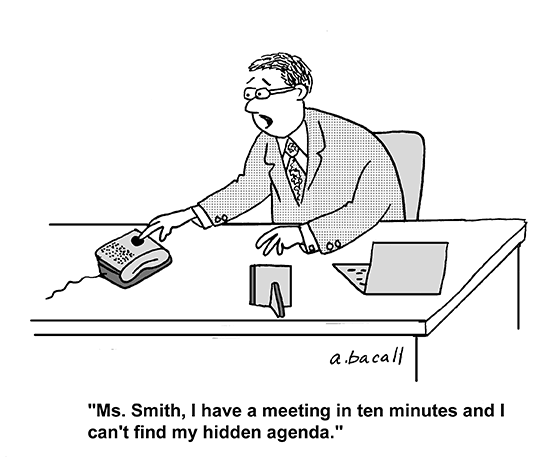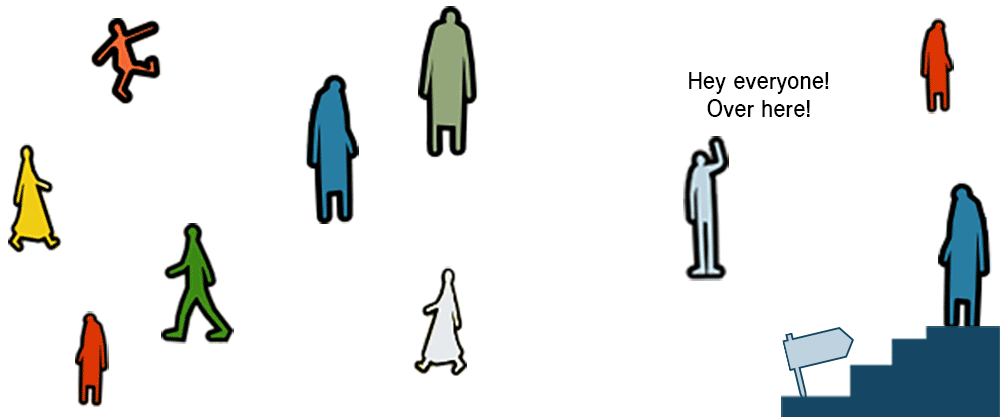The No clue why we’re meeting!” Agenda”
There are times when I put a meeting on my schedule, and I have no good idea why.
I don’t really know the goal of the meeting, there’s no agenda, and I have no clue what the meeting is meant to accomplish.

If you follow this blog, you may find this shocking. One of the more popular posts here is our 5 step guide to canceling bad meetings – and a goal-free meeting definitely qualifies. So what gives?
We’re meeting because someone asked us to.
Our team will occasionally get a meeting request from a potential partner or a client that lacks any specific information about why they want to meet. Like it’s a secret or something. Often, these are people we want to talk to – or in the case of a client, folks we’re very keen to keep happy.
So, while we could push back and ask them to get clearer on the meeting goals, that’s a pretty demanding attitude to take with a client. And as we’ve discussed before, lots of people don’t really know how to structure a useful meeting in the first place, so trying to force them to do so just makes them uncomfortable and shuts down the opportunity.
3 reasons this happens
There are typically three motivations for someone to request a meeting without providing any real reason for it or more details (besides poor manners).
1. Emergence: Let’s see what happens.
Emergence is basically the concept that you get some people together and see what happens. In this case, the meeting request lacks specific details because the person making the request isn’t quite sure what they want to see happen, but they’re interested in investing some time to explore the possibilities.
2. Confidentiality: It really is a secret.
Sometimes you’ll get a meeting request without any details precisely because no one wants to put it in writing. They have something sensitive to discuss, and you’ll learn all about it on the call – which will NOT be recorded.
3. Connection: We’re feeling out of touch.
Finally, if you have a long-running project, you may get a call from a client or partner who “just wants to touch base”. When this happens, it’s a sign that they aren’t feeling well informed and now need to meet so they can understand what’s really going on.
Side note: A request like this is a serious warning sign that your project communication strategy isn’t working.
The agenda to use when there is no agenda
When one of these requests comes in from someone we want or need to work with, we’ll add it to the schedule using our “Basic Agenda”.
The Basic Agenda is our Swiss Army knife, all-purpose, emergency backup tool of choice for prying a productive result out of any haphazard meeting.
It looks like this:
The Basic Agenda
- Welcome
- Discussion
- Review and Next Steps
Simple, right? Deceptively so, because despite the lack of froofery here, there is an art to the design and execution of this agenda that makes it worthwhile.
Here’s how it works.
Step-by-Step: How to Lead the Call and Save the Day
Quick note: This is one of the default templates we provide with every Lucid account, but you could certainly run a meeting using this process outside of Lucid. For best results, you’ll need a way to write things down that everyone can see (a whiteboard or shared doc will do) and a timer or clock so everyone can watch the time.
1. The Welcome
You have two goals for this agenda item.
- Get everyone on the call and welcome them.
- Get a clue and create the conditions for success.
I’ll start with pleasantries and small talk, paying special attention to how each person responds to the ubiquitous “How are you?” question.
If they’re dealing with a sensitive situation, they’ll usually tell you right away. That’s your cue to jump right into the main discussion. Be very careful what you write down in this situation; you’ll want to come out with clear next steps but shouldn’t document anything that could cause problems later. Beware the e-Discovery, my friends!
Usually it’s not an emergency, though, and the meeting will run better if you do a bit of sleuthing.
Question 1. How much time do you have?
It’s really easy for an agenda-free meeting to get all sloppy and run over time. Without any structure to the conversation, people can get into all kinds of interesting ideas and tangents, only to discover they have something really cool to work on just as time runs out.
You can help prevent this up front by asking: is the scheduled time fixed, or is it ok if the meeting runs long? Or, if you must stop on time yourself, saying so up front helps everyone focus on achieving something before time runs out.
Question 2. What would you consider a good result from this conversation?
Put them together, and it sounds something like this.
“We have 30 minutes scheduled today. I want to be mindful of your time; do you need to end right on time today?” or
“We have 30 minutes scheduled today, and I need to end on time to make other commitments.”
then:
“In the time we have together, what would you most like to see happen? In other words, what would a really useful result from this meeting be for you?”
Important: Write down whatever they say.
That’s now the purpose and expected result for your meeting.
Now you’ve set the conditions for success. Boom!

Source: Giphy
2. Discussion
Once you’ve established a shared goal for the call – the aforementioned “really useful result” – move on to the discussion.
If you must end the meeting on time, consider adding a timer to this part of the meeting. You’ll need to close the discussion approximately 5 minutes before the scheduled end time so you can properly close the call.
Then, discuss! Collaborate, listen, learn, and take notes about anything important or that smells like a useful result.
3. Review and Next Steps
Always always always close your meeting by confirming what you just accomplished. Seriously. Always do this.
The final agenda item is where everyone gets to see what you accomplished and agree on what happens next. Without it, people may not have realized you actually accomplished anything and leave the meeting feeling unfulfilled. Don’t deny them the climax! It also gives you a chance to confirm that you really did agree on some things and that people really are going to follow-up on the commitments they made.
In Lucid, we use a Smart List to automatically pull up all the notes we captured in the meeting. This will show us all the “desired results” we wrote down at the beginning of the meeting, and what we captured during the discussion.
If it’s not already obvious, I’ll ask:
“Ok, you said you wanted to achieve …whatever it was… do you feel we did that?”
If yes, hurrah! We all feel like this nebulous meeting time actually went well. If not, then we quickly decide how we’ll work on that goal after the meeting and add some action items to follow-up.
Or, if your discussion was cut short because you started to explore ideas that you didn’t have time to follow through on, you can use this last five minutes to schedule and plan another call. And next time your meeting will have a very clear expected result that you can design an agenda around.
The Result:
You get quadruple bonus points for professionalism and productivity!
To facilitate literally means to make the process easy.
By leading this simple agenda during those times when no one else can even articulate why they’re in the room, you make it easy for them to feel welcome, to express what they need, and then get the satisfaction of seeing their needs addressed. For most people, this kind of clear and tangible result from a meeting is unexpected and surprisingly delightful.
In Lucid, we capture ratings after each meeting and ask for feedback on the process. We get the most glowing responses after these meetings, because we’ve helped the group create a worthwhile outcome despite the lack of advanced preparation.
So next time you’re asked to an apparently goal-free meeting, skip the time you might have spent feeling put out by the imposition and take control. Using the Basic 1–2–3 process outlined above, you now have the tools to make sure your time is always well spent and the people you meet leave impressed.



